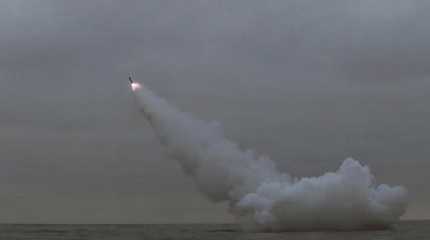
SEOUL, South Korea (AP) — A nuclear-powered U.S. aircraft carrier and its battle group began exercises with South Korean warships on Monday, hours after North Korea fired two short-range ballistic missiles in an apparent protest of the allies’ expanding drills.
The seventh missile test this month underscored heightening tensions in the region as both the North’s weapons tests and the U.S.-South Korea joint military exercises have intensified in a cycle of tit-for-tat.
The launches may have been timed for the arrival of the USS Nimitz and its strike group, including a guided missile cruiser and two destroyers, which engaged in air defense exercises and other drills with South Korean warships in waters near Jeju island.
Jang Do Young, a South Korean navy spokesperson, said the drills were aimed at sharpening joint operational capabilities and demonstrating the U.S. commitment to defend its ally with the full range of options, including nuclear, in face of the North’s “escalating nuclear and missile threats.” The Nimitz strike group was expected to arrive in the South Korean mainland port of Busan on Tuesday.
South Korea’s Joint Chiefs of Staff said the two North Korean missiles were fired from a western inland area south of the North’s capital of Pyongyang from around 7:47 a.m. to 8 a.m. and traveled around 370 kilometers (229 miles) before landing at sea. Japan’s military said the missiles, which landed outside Japan’s exclusive economic zone, flew on an irregular trajectory and reached a maximum altitude of 50 kilometers (31 miles).
Japan has previously used similar language to describe a North Korean solid-fuel missile apparently modeled after Russia’s Iskander mobile ballistic system, which is designed to be maneuverable in low-altitude flight to better evade South Korean missile defenses. North Korea also has another short-range system with similar characteristics that resembles the U.S. MGM-140 Army Tactical Missile System.
Japanese Chief Cabinet Secretary Hirokazu Matsuno said North Korea may dial up its testing activity further with more missile launches or even conducting its first nuclear test since September 2017.
The South Korean and Japanese militaries denounced the latest launches as a serious provocation threatening regional peace and said they were working with the United States to analyze the missiles further. The U.S. Indo Pacific Command said the launches did not pose an immediate threat to the United States or its allies, but still highlighted the “destabilizing impact” of North Korea’s illicit nuclear weapons and missiles programs.
North Korea, which has weathered tightened U.N. Security Council sanctions since 2016 over its nuclear developments, didn’t immediately comment on the launches.
The United States and South Korea completed their biggest springtime exercises in years last week, which had included both computer simulations and live-fire field exercises. But the allies have continued their field training in a show of force against the North’s rising threats.
North Korea, which has weathered tightened U.N. Security Council sanctions since 2016 over its nuclear developments, didn’t immediately comment on the launches.
The United States and South Korea completed their biggest springtime exercises in years last week, which had included both computer simulations and live-fire field exercises. But the allies have continued their field training in a show of force against the North’s rising threats.
The tests also included a purported nuclear-capable underwater drone that the North claimed can set off a huge “radioactive tsunami” and destroy naval vessels and ports. Analysts were skeptical whether such a device was a major new threat and Seoul’s Joint Chiefs of Staff said in a statement Monday that it considers the North Korean claims likely to be “exaggerated and fabricated.”
North Korea, following some of its ballistic and cruise missile tests this month, also claimed that those weapons were tipped with mock nuclear warheads that detonated 600 to 800 meters (1,960 to 2,600 feet) above their sea targets, communicating them as heights that would maximize damage.
North Korea already is coming off a record year in weapons testing, launching more than 70 missiles in 2022. It had set into law an escalatory nuclear doctrine that authorizes pre-emptive nuclear strikes in a broad range of scenarios where it may perceive its leadership as under threat.
“It appears North Korea might be practicing, or signaling that it’s practicing, the use of nuclear strikes, both preemptive and retaliatory, in a range of scenarios that are authorized in its nuclear doctrine,” said Duyeon Kim, a senior analyst at the Center for a New American Security.
“The problem is that continued testing helps Pyongyang perfect its technology, strengthen its nuclear weapons capability that threatens South Korea and Japan, increase the likelihood of miscalculation that could lead to inadvertent conflict, and accumulate political leverage ahead of future diplomatic talks with Washington.”
Following the North’s announcement of the drone test on Friday, South Korea’s air force released details of a five-day joint drill with the United States last week that included live-fire demonstrations of air-to-air and air-to-ground weapons.
The air force said the exercise was aimed at verifying precision strike capabilities and reaffirming the credibility of Seoul’s “three-axis” strategy against North Korean nuclear threats — preemptively striking sources of attacks, intercepting incoming missiles and neutralizing the North’s leadership and key military facilities.




